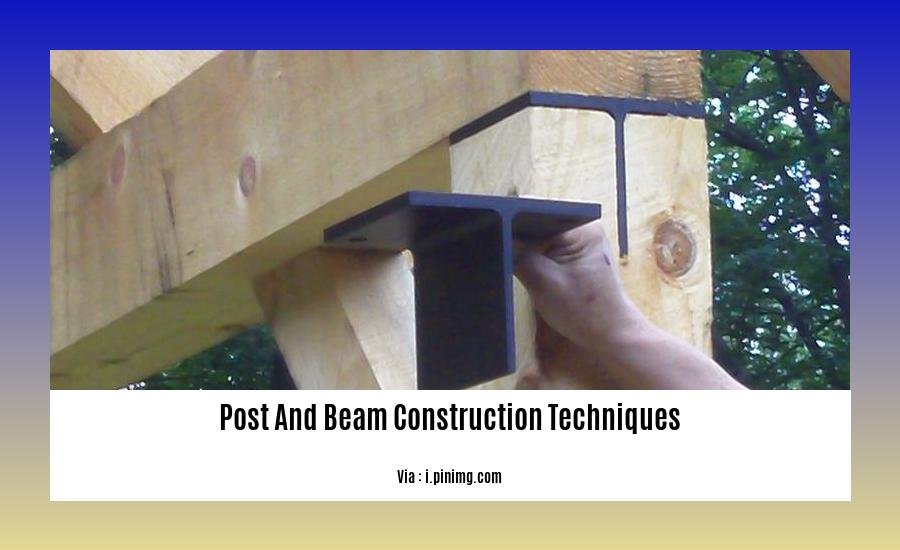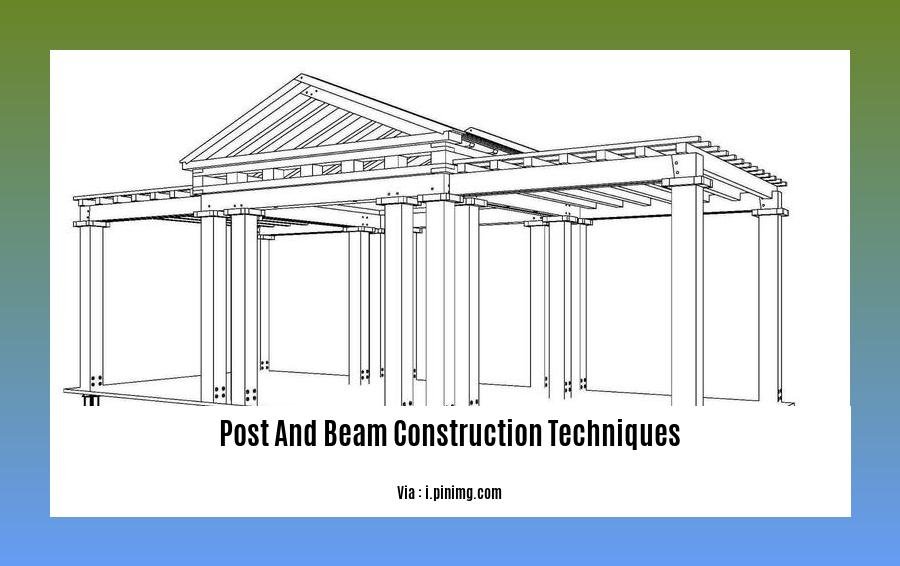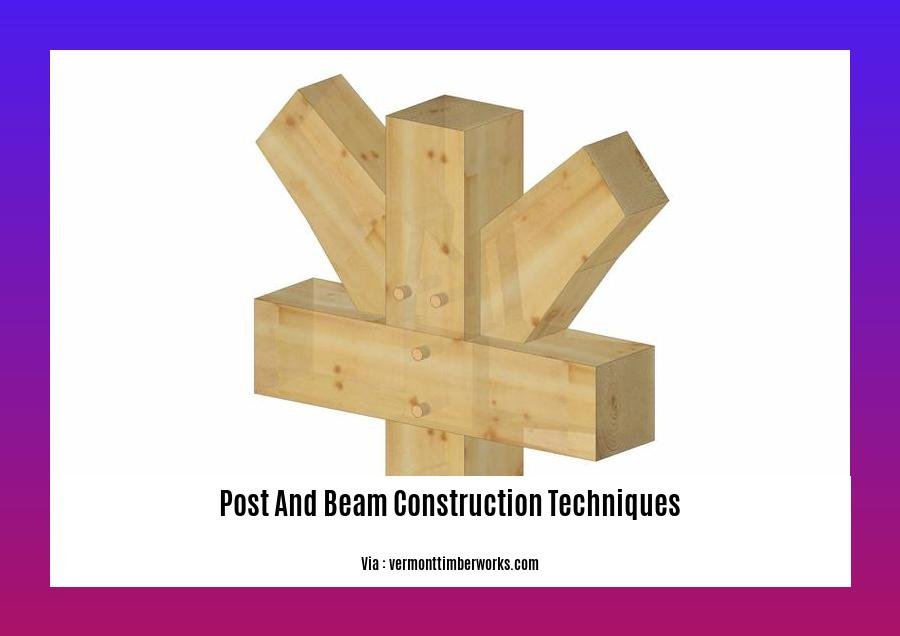– Exploring the Art of Post and Beam Construction Techniques-
Key Takeaways:
- Post and beam construction utilizes heavy timbers for durability and aesthetics.
- Timbers are connected with precise joints, resulting in a strong and flexible structure.
- Exposed beams add warmth and character to interiors.
- Common timbers include oak, Douglas fir, Western red cedar, and redwood.
Post and Beam Construction Techniques: A Guide to Building with Timber

Post and beam construction techniques have been used for centuries to create sturdy and beautiful structures. This traditional building method utilizes heavy timbers called beams and posts to form a durable and aesthetically pleasing framework.
Benefits of Post and Beam Construction
- Flexibility: Post and beam structures allow for open floor plans and extensive customization.
- Strength and Durability: Heavy timbers provide exceptional strength and resilience, making these structures ideal for seismic and wind-prone areas.
- Aesthetics: The exposed wood beams add a touch of warmth and character to the interior space.
Types of Timbers Used
The choice of timber depends on factors such as strength, durability, and availability. Common types used in post and beam construction techniques include:
- Oak
- Douglas Fir
- Western Red Cedar
- Redwood
Building Process
Post and beam construction techniques involve several steps:
- Site Preparation: The building site is prepared, and the foundation is laid.
- Timber Selection: The appropriate timbers are selected based on the design and structural requirements.
- Timber Cutting: The timbers are cut to precise lengths and shapes using specialized tools.
- Notching and Joining: The timbers are notched and joined together using traditional joinery techniques.
- Assembly: The frame is assembled on-site and secured with bolts or wooden pegs.
Advantages and Disadvantages
Advantages:
- Durable and strong
- Allows for open floor plans
- Aesthetically pleasing
Disadvantages:
- Can be more expensive than other building methods
- Requires specialized skills and experience
- Longer construction time compared to some other methods
Choosing the Right Builder
When choosing a builder for your post and beam construction project, it’s crucial to consider their experience, expertise, and track record. Look for builders who are knowledgeable about post and beam techniques, have a proven ability to create durable and aesthetically pleasing structures, and have a good reputation in the industry.
Discover a comprehensive guide on post acl reconstruction exercises to aid in your recovery and regain optimal knee function.
Explore innovative post and beam construction details that enhance structural integrity and create stunning architectural designs.
For seamless home building, utilize post and beam construction kits that provide pre-cut materials and detailed instructions.
Ensure a spotless handover with our post construction clean up checklist, guiding you through every aspect of post-construction tidying.
Budget effectively with our in-depth analysis of post construction clean up cost, empowering you to plan your post-construction expenses wisely.
Mastering Joinery Techniques for Post and Beam Construction

Mastering joinery techniques is essential for achieving the structural integrity and aesthetic appeal of post and beam homes. It involves seamlessly connecting the massive timbers that form the frame of the structure. These techniques include notching, mortise and tenon joints, and dovetail joints.
Proper execution of these joints requires precision and craftsmanship. Notching involves cutting out a section of timber to fit another timber, creating a strong interlocking connection. Mortise and tenon joints involve creating a hole (mortise) in one timber and a corresponding projection (tenon) on another, which are then fitted together. Dovetail joints, known for their strength and aesthetics, involve interlocking wedge-shaped pieces that create a virtually unbreakable bond.
To master joinery techniques, start by familiarizing yourself with the different types of joints and their applications. Practice cutting and fitting the joints using scrap lumber to develop accuracy and consistency. Consider seeking guidance from experienced builders or attending workshops to refine your skills.
Careful attention to detail is key when mastering joinery techniques. Use sharp tools and ensure the timbers are properly aligned before making cuts. Dry fit the joints to check their fit and make any necessary adjustments. Use appropriate fasteners, such as wooden pegs or timber bolts, to secure the joints securely.
By devoting time and effort to mastering joinery techniques, you can not only enhance the structural integrity of your post and beam home but also elevate its aesthetic appeal. The precise and intricate connections will showcase the natural beauty of the wood and create a home that is both durable and visually striking.
Key Takeaways:
- Joiners are crucial for the strength and aesthetics of post and beam homes.
- Notching, mortise and tenon, and dovetail joints are commonly used techniques.
- Precision, attention to detail, and practice are essential for mastering joinery techniques.
- Proper joinery enhances structural integrity and adds aesthetic beauty to post and beam homes.
Sources:
- Fine Homebuilding: Mastering the Mortise and Tenon Joint
- Post and Beam Living: The Art of Joinery in Timber Framing
Exploring Various Finish Options to Enhance the Natural Beauty of Wood
Post and beam construction, renowned for its rustic charm and natural aesthetics, offers a canvas for showcasing the beauty of wood. Finish selection plays a pivotal role in accentuating the grain and tone of the timber, elevating the overall ambiance of your home.
Choosing the Right Finish
Oils and Waxes: Protect and enhance the natural color of the wood, leaving a matte to a satin finish.
Penetrating Finishes: Absorb into the wood, offering protection while maintaining a more natural look.
Film-Forming Finishes: Create a protective layer on the wood’s surface, providing a glossy shine and enhanced color saturation.
Application Considerations
- Preparation: Sand and clean the wood thoroughly before applying any finish.
- Testing: Apply a small amount of the chosen finish to an inconspicuous area to ensure compatibility and desired effect.
- Even Application: Use a brush, cloth, or sponge to apply the finish evenly, following the manufacturer’s instructions.
- Multiple Coats: Apply multiple thin coats rather than one thick one, allowing each coat to dry completely before applying the next.
Tips for Enhancing Wood’s Natural Beauty
- Embrace the Grain: Allow the natural grain patterns to shine through by choosing a finish that complements rather than conceals them.
- Highlight Color: Use stains or dyes to subtly enhance the wood’s hue, adding warmth or richness.
- Add Character: Distress the wood or use a wire brush to create a unique, aged look.
- Consider Lighting: Natural and artificial light can dramatically affect the appearance of wood finishes. Experiment with different lighting sources to find the optimal ambiance.
Key Takeaways:
- Finishes enhance the natural beauty of wood by protection and enhancing its color and grain.
- Choose the right finish based on desired protection, sheen, and aesthetics.
- Prepare the wood thoroughly before applying the finish.
- Apply multiple thin coats evenly to achieve a professional finish.
- Embrace the natural grain and use finishes to accentuate its beauty.
Sources:
- Wood Finishes: Types, Advantages, and How to Choose
- The Ultimate Guide to Wood Finishes
Effective Project Management for Successful Post and Beam Construction
Post and beam construction is a beautiful and durable building method that showcases the natural beauty of wood. However, effective project management is essential to ensure a successful outcome. Here are some key tips:
1. Communication
Open and frequent communication between the design, construction, and engineering teams is vital. Everyone involved should be aware of the project goals, timelines, and challenges.
2. Roles and Responsibilities
Clearly define the roles and responsibilities of each team member. This helps avoid confusion and ensure that everyone is accountable for their work.
3. Project Management Tools
Utilize project management tools such as software or spreadsheets to track progress, manage tasks, and identify potential issues early on.
4. Regular Site Visits
Conduct regular site visits to monitor progress, address any concerns, and provide support to the construction team.
5. Contingency Planning
Have a contingency plan in place to deal with unexpected events, such as weather delays or material shortages.
6. Quality Control
Establish clear quality standards and conduct regular inspections to ensure that the work meets the required specifications.
Key Takeaways:
- Clear communication and coordination are essential.
- Define roles and responsibilities to avoid confusion.
- Utilize project management tools to track progress.
- Conduct regular site visits for monitoring and support.
- Have a contingency plan for unexpected events.
- Establish and maintain high quality standards.
Sources:
- Project Management: Key to Successful Post and Beam Construction
- Effective Project Management for Post and Beam Projects
FAQ
Q1: What are the key advantages of post and beam construction?
A1: Post and beam construction offers several advantages, including flexibility in design, exceptional strength and durability, and a warm and inviting aesthetic due to exposed wood beams.
Q2: What types of timber are commonly used in post and beam construction?
A2: Suitable timber species for post and beam construction include Oak, Douglas Fir, and Western Red Cedar.
Q3: How do post and beam connections contribute to the strength of the structure?
A3: Strong post-to-beam connections, such as mortise and tenon joints, shear plates, and bolts, ensure a rigid and durable frame, enhancing the overall strength of the structure.
Q4: What are some important factors to consider during the design phase of a post and beam project?
A4: Key design considerations include aesthetics, simplicity, cost, and strength. Balancing these factors helps optimize the design to meet specific requirements and preferences.
Q5: How can effective project management contribute to the success of a post and beam construction project?
A5: Clear communication, defined roles and responsibilities, and the use of project management tools facilitate efficient coordination between design, construction, and engineering teams, enabling timely progress and proactive issue resolution.
- The Best Battery Picture Lamps for Effortless Artwork Illumination - April 1, 2025
- Double Sink Bath Vanity Tops: A Buyer’s Guide - April 1, 2025
- Bath Towel Measurements: A Complete Guide to Choosing the Right Size - April 1, 2025










